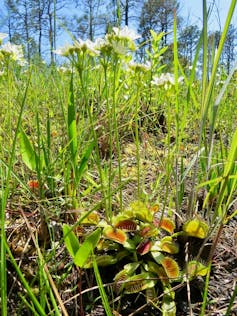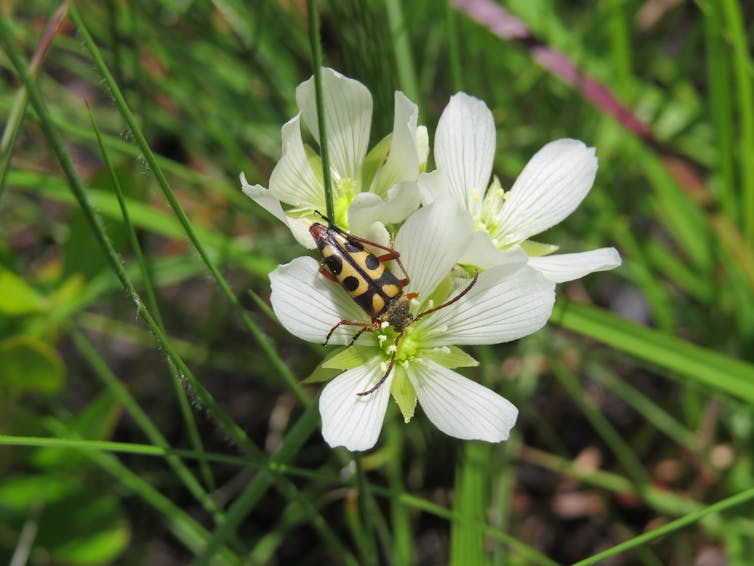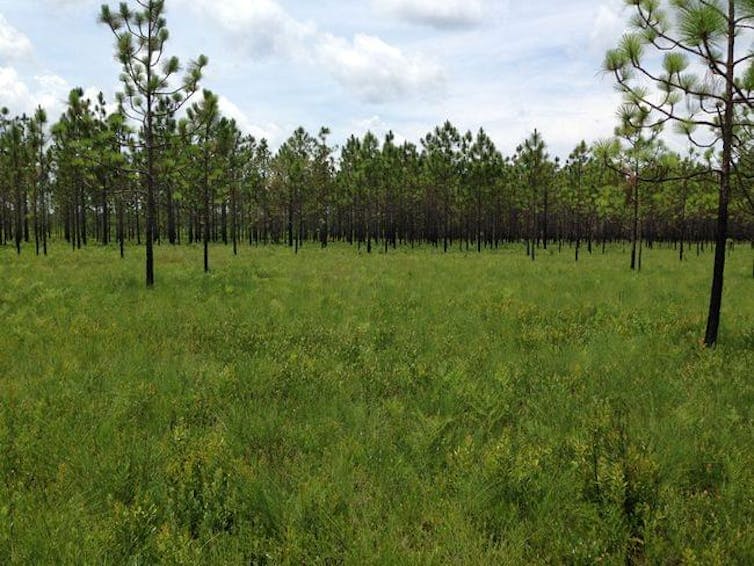Friend or food? Why Venus flytraps don't eat their pollinators
- Written by Clyde Sorenson, Professor of Entomology, North Carolina State University
The Venus flytrap[1], Dionaea muscipula, lives in a tough neighborhood. It only grows in 12 counties in coastal North and South Carolina, in soils that are very nutrient-poor and often waterlogged. To augment these starvation resources, it captures and digests insects and other animal prey.
Of the roughly 600 known species of carnivorous plants worldwide, the Venus flytrap is by far the most famous; it fascinated Charles Darwin and many other naturalists since his time. Scientists have spent an extraordinary amount of time and effort trying to understand how its unique active snap-trap[2] leaves close so quickly. But, for the Venus flytrap, no one has ever paid much attention to the critical service that animals provide for most flowering plants: pollination.
With colleagues at North Carolina State University, the North Carolina Botanical Garden[3] and the U.S. Fish and Wildlife Service[4], we recently set out discover what pollinates the Venus flytrap. We wanted to know whether the plant preyed on the same insects that pollinate it – and if it did not, to begin to understand why.
Flies become meals.The predator’s dilemma
The last thing a carnivorous plant “wants” to do is consume an insect that has pollen on it from another plant of its species – especially if insects that transport the pollen efficiently are uncommon. Eating one’s pollinators wastes the energy used to make that pollen, and it could reduce the number of potential seeds a plant can make.
Scientists have proposed three mechanisms[5] that can help explain how carnivorous plants avoid making this evolutionary mistake. First, the plant’s flowers and traps can open at different times of the growing season, as occurs in some pitcher plants[6]. Second, the flowers and traps can use different attractants, such as scents or colors, as is true of some sundews[7]. Third, its flowers can be located away from its traps.
 Venus flytraps in bloom.
Clyde Sorenson, CC BY-ND[8]
Venus flytraps in bloom.
Clyde Sorenson, CC BY-ND[8]
We know that the Venus flytrap’s flowers and traps are both open at the same time, so separation in time does not explain how the plant avoids eating its allies. The plant’s flowers typically are located 6 to 10 inches above its traps on a long, bare stalk. The traps, which can snap shut in less than a second when anything touches their sensitive trigger hairs, are usually very close to the ground.
The plant’s architecture thus suggests that maybe separation in space helps to protect pollinators. To understand whether or not Venus flytraps successfully avoid eating their pollinators through another mechanism, we first had to compare the insects found on the flowers to those found in the traps.
Identifying flytrap pollinators and prey
We spent a total of almost 30 person-hours collecting all the arthropod visitors we could find in Venus flytrap stands in coastal North Carolina. Most of the insects and spiders we caught were captured straight into small plastic vials, but we used nets for particularly agile individuals.
We put the creatures we captured on dry ice, which quickly killed them, took them back to our lab, and swabbed them with dyed gelatin to remove any pollen. The dye stained the pollen so we could identify and count it. Then we identified the arthropods and the different kinds of pollen they carried, if any. In total we collected, swabbed and identified 409 insects and spiders.
We also carefully removed captured prey from plants’ closed traps and popped these specimens into small vials of alcohol for identification in the lab. Some were still kicking when we extracted them, while others had been reduced to empty husks by the digestive enzymes that flytraps secrete from their leaves when they catch prey. However, we were able to successfully identify 212 individuals.
 Longhorned beetle on a Venus flytrap flower.
Clyde Sorenson, CC BY-ND[9]
Longhorned beetle on a Venus flytrap flower.
Clyde Sorenson, CC BY-ND[9]
Pollinators: Bees and beetles
The Venus flytrap has beautiful, saucer-shaped white flowers about three-quarters of an inch wide. This kind of flower frequently attracts a wide range of insects. We captured almost a hundred different species from flytrap flowers.
Most of the specimens carrying flytrap pollen – which has huge, distinctive grains – were either bees or beetles. A small green sweat bee, a checkered beetle and a flower longhorn beetle appear to be the three most important pollen transporters, measured by their abundance in the flowers and the amount of pollen they carried.
Three-quarters of the insects we retrieved with flytrap pollen on them also carried pollen from other plants blooming at the same time in the vicinity. This told us that most of these insects were not focusing solely on flytraps. Pollinators that carry flytrap pollen and visit other flowers may “waste” the flytrap pollen by depositing it on those flowers. And pollen from other species carried to flytrap flowers by “unfaithful” pollinators can interfere with flytrap pollen, if it finds its way to the flower’s stigma.
Prey: Spiders and ants
The prey items we removed from the traps were also diverse, but two-thirds were either spiders or ants. We did not find any of the 10 most frequent flower visitors in the traps, except for one crab spider. Most of the small proportion of species we found in both traps and flowers did not turn out to be carrying pollen when we retrieved them from flytrap flowers.
These findings indicate that there is very little overlap between prey species and pollinator species. Most of the insects that visit flytrap flowers are capable of flight and use that ability to get to the flowers. In contrast, most of the prey animals find their way into the traps by walking into them. (A better name for the plant might be “Venus spidertrap.”)
Our findings suggest that physical separation between the Venus flytrap’s flowers and traps helps prevent the plant from consuming its pollinators. But we can’t yet rule out other mechanisms that may also help keep the plant from eating its allies.
 Venus flytrap habitat.
Jennifer Koches, USFWS[10]
Venus flytrap habitat.
Jennifer Koches, USFWS[10]
Prized plants
The Venus flytrap is threatened, and its numbers are declining. North and South Carolina’s human populations are growing, and the flytrap’s coastal habitat is highly desirable for development. The plant requires frequent low-intensity fires to maintain its exposure to the sun; in many places, humans have suppressed these fires.
More perniciously, poachers collect the plants illegally for sale to unsuspecting plant lovers. Poaching wild flytraps is now a felony in North Carolina[11]. And a group of scientists has petitioned the U.S. Fish and Wildlife Service to list the Venus flytrap as an endangered species[12]. Going forward, understanding the Venus flytrap’s reproductive ecology will be critical for conserving this remarkable plant.
References
- ^ Venus flytrap (botany.org)
- ^ snap-trap (www.ncbi.nlm.nih.gov)
- ^ North Carolina Botanical Garden (ncbg.unc.edu)
- ^ U.S. Fish and Wildlife Service (www.fws.gov)
- ^ mechanisms (dx.doi.org)
- ^ pitcher plants (www.britannica.com)
- ^ sundews (www.britannica.com)
- ^ CC BY-ND (creativecommons.org)
- ^ CC BY-ND (creativecommons.org)
- ^ Jennifer Koches, USFWS (www.fws.gov)
- ^ felony in North Carolina (www.nytimes.com)
- ^ an endangered species (ecos.fws.gov)
Authors: Clyde Sorenson, Professor of Entomology, North Carolina State University
Read more http://theconversation.com/friend-or-food-why-venus-flytraps-dont-eat-their-pollinators-91620

